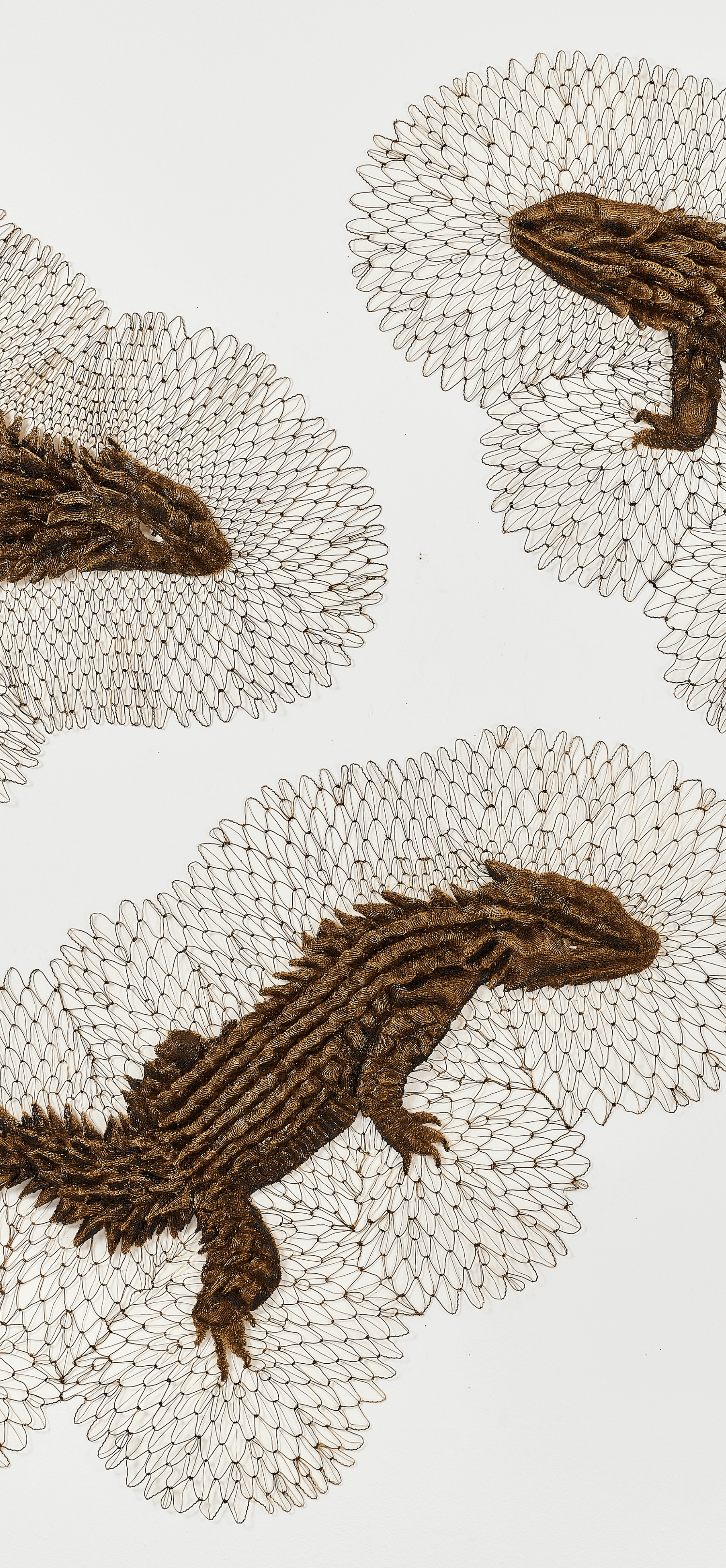
ARMOUR & LACE: A Bestiary presents new works by Walter Oltmann comprising wire sculptures, wall hangings, drawings, prints and paintings. In these works Oltmann explores dynamics between humans, animals and plants, highlighting features of armour, protection and disguise.
Hierarchical exchanges between species raise questions around domination, vulnerability and control and allow for an imagining of alternative ways of being. Drawing on the genre of the bestiary (a compendium of allegorical fables about animals both real and imagined used for moral instruction), Oltmann creates a magical world inhabited by a variety of armoured suits next to armoured animals such as the Sungazer lizard (Smaug Giganteus) and the African pangolin (Smutsia Temminckii).




Such works bring attention to the plight of critically endangered species and the impact of climate change. As a collection of descriptions and interpretations of animals, the bestiary affords a cross-species framework where observation and imagination combine to open up fresh perspectives of and with, other living beings. It presents a fantastic imaginary world where borders between the human and non-human become permeable.
Bestiaries were made popular in the Middle Ages in illuminated manuscripts illustrated by monks. The word ‘illuminated’ comes from the Latin illuminare meaning ‘to light up.’ To achieve such illumination, monks frequently used thin sheets of gold and silver leaf to decorate their images.
Oltmann’s use of gold and silver by way of anodizing aluminium wire in his sculptures as well as introducing gold and copper leaf and fluorescent colours in his drawings, similarly serve to ‘light up’ his chosen subjects, lending them an other-worldly, auratic glow. His subjects are at times playful and humorous but also include images of dead or near-dead creatures. The latter serve as memorials to animals that are not only dying, but literally ‘dying off’, i.e. on the edge of extinction. Images of fossils and skeletal remains similarly function as symbols of posteriority. As portraits of loss, they are meditations on the consequences and impact of environmental distress.
Featured Artworks
Create a Goodman Gallery account to view pricing of available artworks and access purchasing.
Humans are a super predator species and have shown a capacity to consume and deplete animal and plant species at a much higher rate than any other non-human species. Loss of animal and plant populations are an indicator of the effects of human activities such as pollution and habitat destruction. On account of our belief that we are bigger and more powerful than other non human life forms, we forget how interconnected and reliant we are on them and how close to environmental catastrophe we really are.
There is an urgent need to balance our control of the environment with a respectful responsibility towards fellow life forms. Decline in certain insect species, for example, allows other insect species to adapt and thrive, bringing about plagues of pests. Oltmann’s fine wire lace weavings may be seen to convey a sense of fragility, agitation and unease in the face of such threats, carrying images of insects, plants and seeds in states of unrest, eruption and dispersal.

Artist Bio
Walter Oltmann (b. 1960, Rustenburg, North-West Province, South Africa) has an extensive record of creative work produced since the early 1980s, including a number of public commissions. Since the 1980s, he has developed an interest in the relationship between fine art and craft. In his own practice he employs hand-fabricated processes of making and has researched wire craft traditions in southern Africa. In his works, Oltmann makes connections to domestic textile practices and explores such forms of making in evoking fragility and the passage of time. He often combines aspects of decorative ornament with subject matter that seems somewhat contradictory or disturbing in relation to handcrafted embellishment. His sculptural works are executed by way of weaving in wire and using handcrafting methods that reference African and Western traditions of weaving. He is deeply interested in the influence of craft traditions in contemporary South African art.
He obtained a BA Fine Arts degree from the University of Natal, Pietermaritzburg (1981), and an MA Fine Arts degree (1985) and PhD in Fine Arts degree (2017) from the University of the Witwatersrand, Johannesburg – where he worked as a Senior Lecturer and Associate Professor in Fine Arts.
In 2001, Oltmann was awarded the Standard Bank Young Artist Award for Visual Arts. His solo exhibition which followed travelled throughout South Africa. In 2014, the Standard Bank Gallery, Johannesburg hosted his solo show In the Weave which profiled three decades of the artist’s work.
Oltmann received the Claire & Edoardo Villa Will Trust’s Extraordinary Award for Sculpture for 2022, enabling him to produce an extensive body of work, undertaken in the Villa-Legodi workshop at NIROX Sculpture Park where the works were also publicly shown. A book on his work titled In Time will be published shortly.
In his PhD thesis titled In The Weave: Textile-based Modes of Making and the Vocabulary of Handcraft in Selected Contemporary Artworks from South Africa, Oltmann examines how and to what ends contemporary artists working in South Africa have chosen to engage in practices that are common to textile-based handcraft traditions of weaving, stitching and tying. His focus is on how these artists have understood manual work and its philosophy, and how conceptualization in their creative practice is accessed through the physical act of repetitive making by hand, based particularly on those traditional textile craft practices associated with weaving.
Collections include: Iziko South African National Gallery, Cape Town, Norval Foundation, Cape Town and the Seattle Art Museum, Washington.
Oltmann lives and works in Johannesburg, South Africa.


